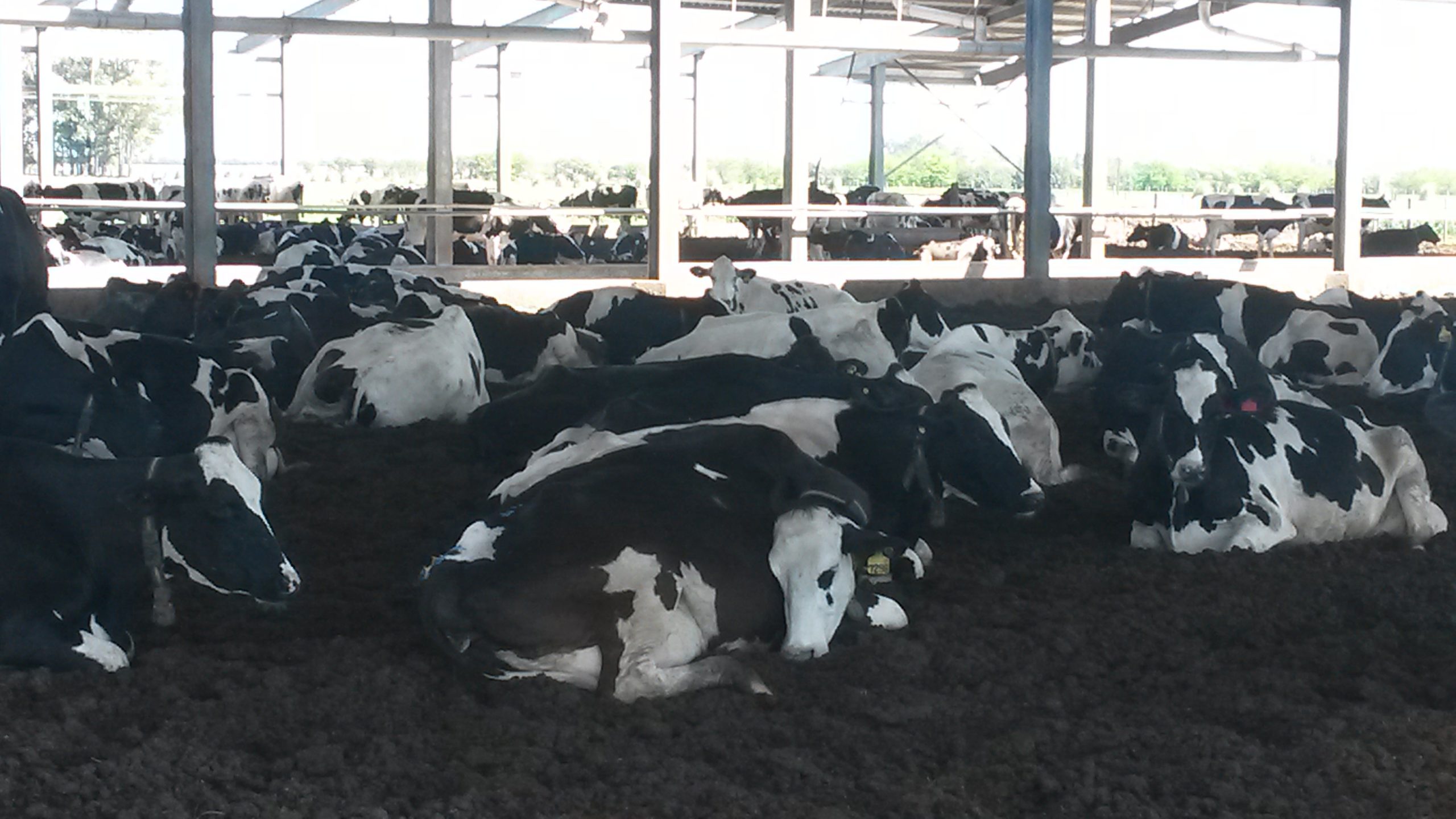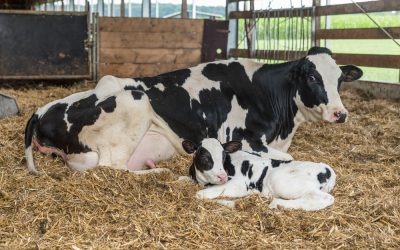D.Temple, F.Bargo, E.Mainau, I.Ipharraguerre, X.Manteca
Download PDF technical sheet
Lying behaviour is a high priority behaviour. Lack of lying and sleep has an impact on both production and welfare of dairy cows. Housing has a substantial effect on the lying behaviour, overall health and performance of dairy cattle. Each housing system has its own advantages and disadvantages in terms of welfare. The successful implementation of a compost bedded system by the Chiavassa farm on the efficiency of production is presented.
IMPORTANCE OF LYING BEHAVIOUR
Dairy cows are highly motivated to lie down for approximately 10-12 h per day. Lying is a high priority behaviour, even higher than eating and social contact when opportunities to perform these behaviours are restricted. Having enough time for lying is important, as reduced lying time can affect both production and welfare in dairy cows. A cow that is lying is more likely to ruminate and produce saliva than a standing cow reducing ruminal acidosis. A lying cow also has an increased blood diffusion through the udder (around 5 L / min) compared with a standing animal (around 3L / min). This improves udder function and milk production. When a cow is standing too much time, the pressure inside the claw capsule increases and produces hypoxia (restricted oxygen supply) and ischemia (restricted blood flow) increasing the risk of lameness. Furthermore, competition for a comfortable resting place can trigger social conflicts between the cows with an increase of chronic stress reaction which predisposes herds to diseases and reproductive problems.
Several behavioural indicators are used to evaluate cows’ comfort around resting such as the time spent lying down, the frequency of lying bouts and the duration of individual bouts. Cows on comfortable flooring lay down for longer times on the entire day and the duration of each lying bout is shorter meaning that cows stand up more frequently and remained standing for shorter periods of time. Cows prefer to remain standing rather than experience the pain associated with lying or rising movement when housed on rough resting surfaces. They may also be an increased number of cows lying partially or totally out of the resting area (e.g. in the passage way) and in uncomfortable stall an increased number of cows is “perching” (with two front feet in the stall and two rear feet in the corridor) inside the stalls.
SLEEP
Adult cattle sleep for about 4h per day, mainly during the night time. Sleep, especially REM sleep (rapid eye movement sleep), occurs most often when the cow is resting with her neck relaxed with the head resting on the flank. Cows well adapted to their surroundings rarely engage in sleep whilst standing. Decreased lying time reduces the possibility for the cows to rest and sleep. A reduction in lying time due to poor housing is likely to have a more severe effect on animal welfare if the time spent sleeping is reduced. Lack of sleep can alter the endocrine system, increase energy cost and impair the immune function.

Cow in typical REM sleep posture at the Chiavassa farm.
MAIN WELFARE PROBLEMS RELATED TO HOUSING
Housing has a substantial impact on the lying behaviour, overall health and performance of dairy cattle. Still, there is no a single best housing system for lactating cows in terms of animal welfare and the management of such system is what will do the difference. Loose housing of cows in stalls is the most common housing in intensive dairy farming. Stalls vary largely in terms of design, type of bedding and floor quality. The dimensions of stalls are not always adjusted to the body size or weight of the cows. Inappropriate stall dimensions increases the number of cows perching inside the stall and lying outside the lying area. Uncomfortable stalls reduce the time lying due to the impossibility to adopt certain resting postures. This will alter sleep patterns thereby having a negative impact on performances. Lying down and rising up movements are improved when the stall is correctly design and made of soft bedding area. Soft flooring surfaces reduce the incidence of swelling of the front knees, which occurs because cows get up and lay down by placing weight on their front knees. The hardness of the lying surface and concrete abrasive and slippery floors increase the risk of injuries and lameness.
Loose housing on deep bedding including straw or compost is practiced only by a small number of farms in Europe, still its popularity is increasing. Dairy cows have a clear preference for standing and lying in a straw yard system rather than in a stall system and the longest durations of lying time are reported on deep bedded systems. Behavioural indicators related to resting suggest that cows are more comfortable on bedded pack barns than in stalls. The incidence of injuries to both the front and hind legs is also reduce in deep litter systems. However, deep litter systems require an intensive labour and higher costs related to the bedding material. If not correctly managed deep litter systems can trigger problems related to the hygiene of the animals. Cows tend to be dirtier in deep bedding systems increasing the risk of mastitis. Cows avoid manure-covered floors in preference for those that are dry, wet or consist of earth. Good hygiene is essential to reduce the incidence of infectious diseases. Moreover, excessive manure on the floor softens the horn, which then are more prone to mechanical damage. Interdigital skin gets softer because of the accumulated manure, which exposes deeper tissues to be attacked by microorganisms and predisposes for infectious diseases. The quality of the bedding area and its management are very important to prevent diseases related to cow dirtiness.
” PROMOTE APPROPRIATE LYING BEHAVIOUR INCREASES THE EFFICIENCY OF PRODUCTION”
PRACTICAL CASE- CHIAVASSA FARM
The Chiavassa dairy farm is located in the province of Santa Fe, in Argentina, and houses around 1,000 Holstein cows milked in a confined TMR diet/regime, with a batch of 300 highly productive cows. Every day, actual dry matter intake is estimated by calculating the difference between what is offered and rejected.
In 2014, Chiavassa invested in new facilities of loose housing system with compost bedded pack for the high productive cows. Cows were previously housed on loose housing system on earth flooring. It is important to remember that a well functioning compost bedded system requires a demanding daily maintenance of the compost. Besides, cows must have sufficient space allowance.
The impact of such changes in the housing facilities on dry matter intake, milk production and conversion efficiency was monitored. During the 3 months following the change of housing, high production cows increased 30% their conversion efficiency (1.80 vs. 1.40 litres / kg DM) for a similar dry matter intake (27.5 kg / day). In other words, consuming the same amount of food, cows housed in the new compost bedded system produced 49 litres / day instead of 39 litres / day. The economic impact expressed in terms of free feed litres was 36% (38.5 vs. 28.3 litres / day). No increased in the SCC was reported (see Table).
Changes in efficiency, consumption and production in high-producing cows when moving from the old above-ground facility to a new facility with heated compost bedding.
| Old installations | New installations with compost bed | Change | |
| Conversion efficiency (L/kg DM) | 1,40 | 1,80 | + 29% |
| Dry matter intake (kg/day) | 27,7 | 27,2 | – 2% |
| Milk production (L/day) | 38,7 | 48,7 | + 26% |
| Free litres of feed (L/day) | 28,3 | 38,5 | + 36% |
Summary
| Dairy cows have a very high motivation to rest for approximately 10 – 12 h per day. Comfortable facilities result in an increase in both lying and sleeping time, which has a positive effect on production. The experience of the Chiavassa Group shows that investing in improving cow welfare has a positive impact on the economic results due to a significant improvement in feed to milk conversion efficiency. |
REFERENCES
- Grupo Chiavassa – grupochiavassa.com/web
- Cook NB, Nordlund KV 2009. The influence of the environment on dairy cow behavior, claw health and herd lameness dynamics. Veterinary Journal 179: 360-369.
- EFSA 2009 Effects of farming systems on dairy cow welfare and disease Report of the Panel on Animal Health and Welfare. Scientific report of EFSA prepared by the Animal Health and Animal Welfare Unit on the effects of farming systems on dairy cow welfare and disease. Annex to the EFSA Journal 1143: 1-7.
- Endres MI, Barberg AE 2007. Behavior of dairy cows in an alternative beddedpack housing system. Journal of Dairy Science, 90: 4192-4200.
- Munksgaard L, Jensen MB, Pedersen LJ, Hansen SW, Matthews L 2005. Quantifying behavioural priorities – Effects of time constraints on behaviour of dairy cows, Bos taurus. Applied Animal Behaviour Science 92: 3-14.



